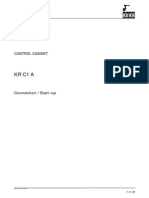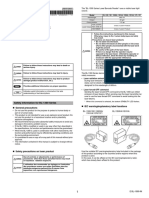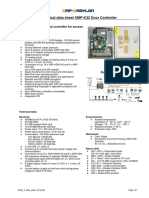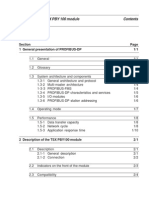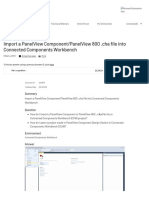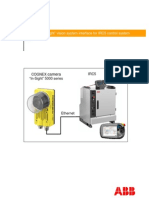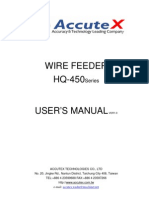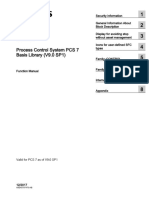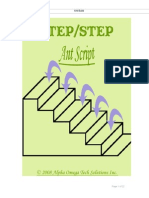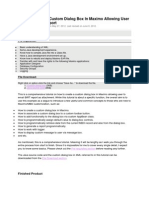VAL3 Version s6.x - VAL3 XML Format
VAL3 Version s6.x - VAL3 XML Format
Uploaded by
Francisco Javier Martín GilCopyright:
Available Formats
VAL3 Version s6.x - VAL3 XML Format
VAL3 Version s6.x - VAL3 XML Format
Uploaded by
Francisco Javier Martín GilOriginal Description:
Original Title
Copyright
Available Formats
Share this document
Did you find this document useful?
Is this content inappropriate?
Copyright:
Available Formats
VAL3 Version s6.x - VAL3 XML Format
VAL3 Version s6.x - VAL3 XML Format
Uploaded by
Francisco Javier Martín GilCopyright:
Available Formats
SPECIFICATIONS DU FORMAT VAL3 - XML
FAVERGES
01.07.2004
Contents
1. Document Purpose............................................................................................................................. 1
2. VAL3 Architecture .............................................................................................................................. 1
3. fileS specification................................................................................................................................ 2
3.1.
Project file.................................................................................................................................. 2
3.1.1.
Example............................................................................................................................ 3
3.2.
Data file ..................................................................................................................................... 3
3.2.1.
aio type ............................................................................................................................. 4
3.2.2.
bool type ........................................................................................................................... 4
3.2.3.
config for Scara (Rs) ......................................................................................................... 4
3.2.4.
config for Anthropomorphic Arm (Rx/Tx)........................................................................... 5
3.2.5.
Special config.................................................................................................................... 5
3.2.6.
dio type ............................................................................................................................. 6
3.2.7.
frame type......................................................................................................................... 6
3.2.8.
joint type for Scara Arm (Rs)............................................................................................. 7
3.2.9.
joint type for anthropomorphic Arm (Rx/Tx) ...................................................................... 7
3.2.10. Special Joint...................................................................................................................... 8
3.2.11. mdesc type........................................................................................................................ 8
3.2.12. num type ........................................................................................................................... 9
3.2.13. Point for Scara arm (Rs) ................................................................................................... 9
3.2.14. Point for anthropomorphic arm (Rx/Tx)........................................................................... 10
3.2.15. Special Point................................................................................................................... 11
3.2.16. sio type ........................................................................................................................... 11
3.2.17. string type ....................................................................................................................... 11
3.2.18. tool type .......................................................................................................................... 11
3.2.19. trsf type ........................................................................................................................... 12
3.2.20. Example of file ................................................................................................................ 13
3.3.
Program file ............................................................................................................................. 14
3.3.1.
Example:......................................................................................................................... 14
1.
DOCUMENT PURPOSE
This paper presents the XML specification for the VAL3 up to s5.2 version.
Each VAL3 file (project, data and program) is saved in an XML format
2. VAL3 ARCHITECTURE
A VAL3 project is organized with 3 kinds of file. The project file that contents the project parameters and
the list of all the files (data and program) concerning by the project. All the files must be in the same
directory and the directory must have the same name of the project file name.
1/15
STUBLI FAVERGES
Place Robert Stubli - BP 70
74210 FAVERGES FRANCE
Tl 33 (0)4 50 65 60 60- Fax 33(0)4 50 65 60 70
www.staubli.com - ISO 9001
S.C.A au Capital 7 718 400
R.C.S Annecy B 325 720 720
N Identification T.V.A FR 80 325 720 720
NAF 295 G
SPECIFICATIONS DU FORMAT VAL3 - XML
FAVERGES
01.07.2004
The file extensions are:
PJX for project file
DTX for data file
PGX for program file
Example: a project named dummy with two programs start and stop
C:\
usrapp
dummy
dummy.pjx
dummy.dtx
start.pgx
stop.pgx
3. FILES SPECIFICATION
All the files are stored in XML.
The encoding code is iso-8859-1 for version VAL3 before s6.* and utf-8 for VAL3 version s6.* and
after.
Example:
<?xml version="1.0" encoding="utf-8" ?>
CAUTION: all the tags and attributes are case sensitive.
3.1. Project file
The project file lists all the files of the project.
The main tag is project and the namespace is ProjectNameSpace
The tag for the parameters is parameters and has the following attributes:
version specify the version of the VAL3 for this project
stackSize specify the size of the stack of each task of project (must be greater than 0)
millimeter unit is true if the unit is millimeter, false for inch
Then three sections are presents to define the project files.
The program section contains all the program files and the tag is programSection
Each program file is declared with the tag program and the attribute file for the name of the file.
<program file="start.pgx" />
The data section contains the data file and the tag is dataSection
The data file is declared with the tag data and the attribute file for the name of the file.
CAUTION: Only one data file is supported.
2/15
SPECIFICATIONS DU FORMAT VAL3 - XML
FAVERGES
01.07.2004
<data file="dummy.dtx" />
The libraries section contains the libraries and the tag is aliasSection
The library is declared with the tag alias and its attributes;
1. The name for the name of the alias.
2. The interface for the path of the library.
3. The autoload that is true if library must be loaded with the project.
4. The password that specifies password for encrypted library. (optional attribute)
Example:
<alias name="io" interface="io" autoload="true" password="" />
3.1.1. Example
<?xml version="1.0" encoding="utf-8" ?>
<project xmlns="ProjectNameSpace" >
<parameters version="~VAL3:v4.0" stackSize="5000" millimeterUnit="true" />
<programSection>
<program file="start.pgx" />
<program file="stop.pgx" />
</programSection>
<dataSection>
<data file="main.dtx" />
</dataSection>
<aliasSection>
<alias name="io" interface="io" autoload="true" />
<alias name="lib" interface="lib1" autoload="true" />
</aliasSection>
</project>
3.2. Data file
The data file lists all the data of the project.
The main tag is dataList and the namespace is DataNameSpace
Then one section for each type contains all the data of this type.
CAUTION: the section must be in alphabetic order.
Each data has a name and a visibility.
The name is an attribute called name and is limited to 15 characters. A name must begin with a character
between [a-z] or [A-Z] or _. After the first only following characters are authorized [a-z] [A-Z]
[0-9] _
The visibility of a data is public for data that can be accessed by other project or private for data that is
reserved for the owner project. The attribute name is public
3/15
SPECIFICATIONS DU FORMAT VAL3 - XML
FAVERGES
01.07.2004
Each value of the data is stored inside the data element with special tag for each type (see below). In
each value element an index attribute specify the row of the element in the array. This index is a zero
based index. Its forbidden to have two values with the same index value in the same data.
The size of a data (array or not) is determined by the number of values. If it has more than one value, its
an array.
CAUTION: Except for the type aio, dio and sio a data must contain at least one value.
3.2.1. aio type
The tag for all aio data is aioSection. The tag for an aio data is aio.
An aio has no value. So a special attribute size permits to specify an array (greater than 1) or simple
data.
The size must be greater than 0.
<aioSection>
<aio size="1" name="aAio1" public="false" />
<aio size="3" name="aAioArray" public="false" />
</aioSection>
3.2.2. bool type
The tag for all boolean data is boolSection. The tag for a boolean data is bool.
The tag for the value of a boolean is valueBool. The content of the value is an attribute name value.
CAUTION: the constant true and false must be in lower case.
<boolSection>
<bool name="bBool1" public="false">
<valueBool value="false" index="0" />
</bool>
<bool name="bBoolArray" public="false">
<valueBool value="false" index="0" />
<valueBool value="true" index="1" />
<valueBool value="false" index="2" />
</bool>
</boolSection>
3.2.3. config for Scara (Rs)
The tag for all Scara config data is configRsSection. The tag for a Scara config data is configRs.
The tag for the value of a Scara config data is valueConfigRs. The content of the value is a sub
element of valueConfigRs named configRsValue. This sub element contains one attribute:
shoulder shoulder position, can be
ssame, sfree, righty, lefty
4/15
SPECIFICATIONS DU FORMAT VAL3 - XML
FAVERGES
01.07.2004
<configRsSection>
<configRs name="cConfigRs1" public="false">
<valueConfigRs index="0">
<configRsValue shoulder="ssame" />
</valueConfigRs>
</configRs>
<configRs name="cConfigRs2" public="false">
<valueConfigRs index="0">
<configRsValue shoulder="ssame" />
</valueConfigRs>
<valueConfigRs index="1">
<configRsValue shoulder="sfree" />
</valueConfigRs>
</configRs>
</configRsSection>
3.2.4. config for Anthropomorphic Arm (Rx/Tx)
The tag for all Rx/Tx config data is configSection. The tag for a Rx/Tx config data is config.
The tag for the value of a Rx/Tx config data is valueConfig. The content of the value is a sub element
of valueConfig named configValue. This sub element contains three attributes:
shoulder shoulder position, can be
ssame, sfree, righty, lefty
elbow
elbow position, can be
esame, efree, epositive, enegative
- wrist
wrist position, can be
wsame, wfree, wpositive, wnegative
<configSection>
<config name="cConfig1" public="false">
<valueConfig index="0">
<configValue shoulder="sfree" elbow="efree" wrist="wfree" />
</valueConfig>
</config>
<config name="cConfigArray" public="false">
<valueConfig index="0">
<configValue shoulder="sfree" elbow="efree" wrist="wfree" />
</valueConfig>
<valueConfig index="1">
<configValue shoulder="ssame" elbow="esame" wrist="zsame" />
</valueConfig>
</config>
</configSection>
3.2.5. Special config
Then, a special empty section must be placed.
5/15
SPECIFICATIONS DU FORMAT VAL3 - XML
FAVERGES
01.07.2004
<configVrbSection />
3.2.6. dio type
The tag for all dio data is dioSection. The tag for a dio data is dio.
A dio has no value. So a special attribute size permits to specify an array (greater than 1) or simple data.
The size must be greater then 0.
<dioSection>
<dio size="1" name="dDio1" public="false" />
<dio size="21" name="dDioArray" public="false" />
</dioSection>
3.2.7. frame type
The tag for all frame data is frameSection. The tag for a joint data is frame.
The frame father is stored in a sub element tagged fFather with three attributes:
- alias
alias of the library where the frame father is. Empty if in the same project
name of the father frame.
- name
- fatherIndex zero based index of the value if the father is an array. zero if not an array
The tag for the value of a frame data is valueFrame. The content of the value is a sub element of
valueFrame named tfValue. This sub element contains the same attributes as a trsfVvalue.
A special frame named world is the root of the frame hierarchy and so has no father. The attribute name
of the fFather element must be empty.
<frameSection>
<frame name="world" public="false" privilege="0">
<fFather alias="" name="" fatherIndex="0" />
<valueFrame index="0">
<tfValue x="0" y="0" z="0" rx="0" ry="0" rz="0" />
</valueFrame>
</frame>
<frame name="fFrame1" public="false">
<fFather alias="" name="world" fatherIndex="0" />
<valueFrame index="0">
<tfValue x="0" y="0" z="0" rx="0" ry="0" rz="0" />
</valueFrame>
<valueFrame index="1">
<tfValue x="0" y="0" z="0" rx="0" ry="0" rz="0" />
</valueFrame>
</frame>
</frameSection>
6/15
SPECIFICATIONS DU FORMAT VAL3 - XML
FAVERGES
01.07.2004
3.2.8. joint type for Scara Arm (Rs)
The tag for all joint data for Scara is jointRsSection. The tag for a joint Scara data is jointRs.
The tag for the value of a joint Scara data is valueJointRs. The content of the value is a sub element of
valueJointRs named jointRsValue. This sub element contains four attributes j1, j2, j3, j4
<jointRsSection>
<jointRs name="jJointRs1" public="false">
<valueJointRs index="0">
<jointRsValue j1="0" j2="0" j3="0" j4="0" />
</valueJointRs>
</jointRs>
<jointRs name="jJointRs2" public="false">
<valueJointRs index="0">
<jointRsValue j1="0" j2="0" j3="0" j4="0" />
</valueJointRs>
<valueJointRs index="1">
<jointRsValue j1="1" j2="2" j3="3" j4="4" />
</valueJointRs>
</jointRs>
</jointRsSection>
3.2.9. joint type for anthropomorphic Arm (Rx/Tx)
The tag for all joint data for Rx/Tx is jointSection. The tag for a joint Rx/Tx data is joint.
The tag for the value of a joint Rx/Tx data is valueJoint. The content of the value is a sub element of
valueJoint named jointValue. This sub element contains six attributes j1, j2, j3, j4, j5,
j6.
<jointSection>
<joint name="jJoint1" public="false">
<valueJoint index="0">
<jointValue j1="0" j2="0" j3="0" j4="0"
</valueJoint>
</joint>
<joint name="jJointArray" public="false">
<valueJoint index="0">
<jointValue j1="0" j2="0" j3="0" j4="0"
</valueJoint>
<valueJoint index="1">
<jointValue j1="0" j2="0" j3="0" j4="0"
</valueJoint>
<valueJoint index="2">
<jointValue j1="0" j2="0" j3="0" j4="0"
</valueJoint>
</joint>
</jointSection>
j5="0" j6="0" />
j5="0" j6="0" />
j5="0" j6="0" />
j5="0" j6="0" />
7/15
SPECIFICATIONS DU FORMAT VAL3 - XML
FAVERGES
01.07.2004
3.2.10. Special Joint
Then, a special empty section must be placed.
<jointVrbSection />
3.2.11. mdesc type
The tag for all mdesc data is mdescSection. The tag for a joint data is mdesc.
The tag for the value of a mdesc data is valueMdesc. The content of the value is a sub element of
valueMdesc named mdescValue. This sub element contains attributes:
- accel
Maximum permitted revolute acceleration as a % of the nominal acceleration of
the robot
vel
Maximum permitted revolute speed as a % of the nominal speed of the robot.
decel
Maximum permitted revolute deceleration as a % of the nominal deceleration of
the robot
tmax
Maximum permitted translational speed of the tool centre point, in mm/s or
inches/s depending on the unit of length of the application
rmax
Maximum permitted rotational speed of the tool centre point, in degrees per
second
blend
Blend mode: off (no blending), or joint (blending)
leave
In joint blend mode, distance between the target point at which blending starts
and the next point, in mm or inches, depending on the unit of length of the
application
reach
In joint blend mode, distance between the target point at which blending stops
and the next point, in mm or inches, depending on the unit of length of the
application
8/15
SPECIFICATIONS DU FORMAT VAL3 - XML
FAVERGES
01.07.2004
<mdescSection>
<mdesc name=" mMdesc1" public="true" >
<valueMdesc index="0">
<mdescValue
accel="100" vel="100" decel="100"
tmax="99999" rmax="9999"
blend="off" leave="51" reach="50" />
</valueMdesc>
</mdesc>
<mdesc name=" mMdescArray" public="true" >
<valueMdesc index="0">
<mdescValue
accel="100" vel="100" decel="100"
tmax="99999" rmax="9999"
blend="off" leave="51" reach="50" />
</valueMdesc>
<valueMdesc index="2">
<mdescValue
accel="10" vel="1 decel="10"
tmax="99999" rmax="9999"
blend="off" leave="51" reach="50" />
</valueMdesc>
</mdesc>
</mdescSection>
3.2.12. num type
The tag for all numeric data is numSection. The tag for a numeric data is num.
The tag for the value of a numeric is valueNum. The content of the value is an attribute name value.
<numSection>
<num name="nNum1" public="false">
<valueNum value="0" index="0" />
</num>
<num name="nNumArray" public="false">
<valueNum value="0" index="0" />
<valueNum value="87" index="1" />
<valueNum value="45" index="2" />
</num>
</numSection>
3.2.13. Point for Scara arm (Rs)
The tag for all point data of an Scara is pointRsSection. The tag for a point (Scara) data is pointRs.
The point Scara father is stored in a sub element tagged pRsFather with three attributes:
- alias
alias of the library where the frame father is. Empty if in the same project
- name
name of the father frame.
- fatherIndex zero based index of the value if the father is an array. zero if not an array
The tag for the value of a point (Scara) data is valuePointRs. The content of the value is two sub
element of valuePointRs named:
9/15
SPECIFICATIONS DU FORMAT VAL3 - XML
FAVERGES
-
01.07.2004
trsf value of the point (see trsfValue)
cpRsValue config value of the point (see configRsValue)
tpRsValue
<pointRsSection>
<pointRs name="pPointRs1" public="false">
<pRsFather alias="" name="fFrame2" fatherIndex="0" />
<valuePointRs index="0">
<tpRsValue x="0" y="0" z="0" rx="0" ry="0" rz="0" />
<cpRsValue shoulder="ssame" />
</valuePointRs>
</pointRs>
<pointRs name="pPointRs2" public="false">
<pRsFather alias="" name="World" " fatherIndex="0" />
<valuePointRs index="0">
<tpRsValue x="0" y="0" z="0" rx="0" ry="0" rz="0" />
<cpRsValue shoulder="sfree" />
</valuePointRs>
<valuePointRs index="1">
<tpRsValue x="0" y="0" z="0" rx="0" ry="0" rz="0" />
<cpRsValue shoulder="ssame" />
</valuePointRs>
</pointRs>
</pointRsSection>
3.2.14. Point for anthropomorphic arm (Rx/Tx)
The tag for all point data of an Rx/Tx is pointSection. The tag for a point (Rx/Tx) data is point.
The point Rx/Tx father is stored in a sub element tagged pFather with three attributes:
- alias
alias of the library where the frame father is. Empty if in the same project
- name
name of the father frame.
- fatherIndex zero based index of the value if the father is an array. zero if not an array
The tag for the value of a point (Rx/Tx) data is valuePoint. The content of the value is two sub element
of valuePoint named:
tpValue trsf value of the point (see trsfValue)
cpValue config value of the point (see configValue)
<pointSection>
<point name="pPoint1" public="false">
<pFather alias="" name="fFrame1" fatherIndex="0" />
<valuePoint index="0">
<tpValue x="0" y="0" z="0" rx="0" ry="0" rz="0" />
<cpValue shoulder="sfree" elbow="efree" wrist="wfree" />
</valuePoint>
</point>
<point name="pPointArray" public="false">
<pFather alias="" name="world" fatherIndex="0" />
10/15
SPECIFICATIONS DU FORMAT VAL3 - XML
FAVERGES
01.07.2004
<valuePoint index="0">
<tpValue x="0" y="0" z="0" rx="0" ry="0" rz="0" />
<cpValue shoulder="sfree" elbow="efree" wrist="wfree" />
</valuePoint>
<valuePoint index="1">
<tpValue x="0" y="0" z="0" rx="0" ry="0" rz="0" />
<cpValue shoulder="sfree" elbow="efree" wrist="wfree" />
</valuePoint>
<valuePoint index="2">
<tpValue x="0" y="0" z="0" rx="0" ry="0" rz="0" />
<cpValue shoulder="sfree" elbow="efree" wrist="wfree" />
</valuePoint>
</point>
</pointSection>
3.2.15. Special Point
Then, a special empty section must be placed.
<pointVrbSection />
3.2.16. sio type
The tag for all sio data is sioSection. The tag for a sio data is sio.
A sio has no value. So a special attribute size permits to specify an array (greater than 1) or simple data.
The size must be greater then 0.
<sioSection>
<sio size="1" name="sSio1" public="false" />
<sio size="21" name="sSioArray" public="false" />
</sioSection>
3.2.17. string type
The tag for all string data is stringSection. The tag for a string data is string.
The tag for the value of a string is valueString. The content of the value is an attribute name value.
<stringSection>
<string name="sString1" public="false">
<valueString value="a string" index="0" />
</string>
<string name="sString1" public="false">
<valueString value="string one" index="0" />
<valueString value="string two" index="1" />
</string>
</stringSection>
3.2.18. tool type
The tag for all tool data is toolSection. The tag for a joint data is tool.
11/15
SPECIFICATIONS DU FORMAT VAL3 - XML
FAVERGES
01.07.2004
The tool father is stored in a sub element tagged tFather with three attributes:
- alias
alias of the library where the frame father is. Empty if in the same project
- name
name of the father frame.
- fatherIndex zero based index of the value if the father is an array. zero if not an array
The tag for the value of a tool data is valueTool. The content of the value is two sub elements
ttValue trsf value of the point (see trsfValue)
io
element for the i/o definition it contains 5 attributes:
alias must be io
name name of the io
ioIndex index of the io if in an array
open open stabilization time
close closing stabilization time
A special tool named flange is the root of the frame hierarchy and so has no father. The attribute name
of the tFather element must be empty.
<toolSection>
<tool name="flange" public="false" privilege="0">
<tFather alias="" name="" fatherIndex="0" />
<valueTool index="0">
<ttValue x="0" y="0" z="0" rx="0" ry="0" rz="0" />
<io alias="io" name="valve1" ioIndex="0" open="0" close="0" />
</valueTool>
</tool>
<tool name="tlTool1" public="false">
<tFather alias="" name="flange" fatherIndex="0" />
<valueTool index="0">
<ttValue x="1" y="0" z="0" rx="0" ry="0" rz="0" />
<io alias="io" name="valve1" ioIndex="0" open="0" close="0" />
</valueTool>
<valueTool index="1">
<ttValue x="1" y="0" z="0" rx="0" ry="0" rz="0" />
<io alias="io" name="valve1" ioIndex="0" open="0" close="0" />
</valueTool>
</tool>
</toolSection>
3.2.19. trsf type
The tag for all trsf data is trsfSection. The tag for a trsf data is trsf.
The tag for the value of a trsf data is valueTrsf. The content of the value is a sub element of
valueTrsf named trsfValue. This sub element contains six attributes x, y, z, rx, ry, rz.
12/15
SPECIFICATIONS DU FORMAT VAL3 - XML
FAVERGES
01.07.2004
<trsfSection>
<trsf name="trTrsf1" public="false">
<valueTrsf index="0">
<trsfValue x="0" y="0" z="0" rx="0" ry="0" rz="0" />
</valueTrsf>
</trsf>
<trsf name="trTrsfArray" public="false">
<valueTrsf index="0">
<trsfValue x="0" y="0" z="0" rx="0" ry="0" rz="0" />
</valueTrsf>
<valueTrsf index="1">
<trsfValue x="0" y="0" z="0" rx="0" ry="0" rz="0" />
</valueTrsf>
</trsf>
</trsfSection>
3.2.20. Example of file
<?xml version="1.0" encoding="utf-8"?>
<dataList xmlns="DataNameSpace">
<aioSection />
<boolSection />
<configSection />
<dioSection />
<frameSection>
<frame name="world" public="false" privilege="0">
<fFather alias="" name="" fatherIndex="0" />
<valueFrame index="0">
<tfValue x="0" y="0" z="0" rx="0" ry="0" rz="0" />
</valueFrame>
</frame>
</frameSection>
<jointSection />
<mdescSection>
<mdesc name="nom_speed" public="true" privilege="0">
<valueMdesc index="0">
<mdescValue
accel="100" vel="100" decel="100"
tmax="99999" rmax="9999"
blend="off" leave="50" reach="50" />
</valueMdesc>
</mdesc>
</mdescSection>
<numSection />
<pointSection />
<sioSection />
<stringSection />
<toolSection>
<tool name="flange" public="false" privilege="0">
<tFather alias="" name="" fatherIndex="0" />
<valueTool index="0">
13/15
SPECIFICATIONS DU FORMAT VAL3 - XML
FAVERGES
01.07.2004
<ttValue x="0" y="0" z="0" rx="0" ry="0" rz="0" />
<io alias="io" name="valve1" ioIndex="0" open="0" close="0" />
</valueTool>
</tool>
</toolSection>
<trsfSection />
</dataList>
3.3. Program file
The program file contains the code of VAL3 program.
The main tag is programList and the namespace is ProgramNameSpace
The element for one program is tagged program. The attribute name qualifies the name of the program
and the attribute public is true if the program is visible from another project (false else).
The name is limited to 15 characters. A name must begin with a character between [a-z] or [A-Z] or _.
After the first only following characters are authorized [a-z] [A-Z] [0-9] _
An element tagged description permits to describe the program on one line.
The parameters list is described in an element named paramSection. Each parameter is an element
tagged param. It owns three attributes:
- name name of the parameter (see data file description for name convention)
- type type of the parameter (see data file description for exhaustive list )
- byVal true if the parameter is passed by value, false else.
The local variables list is described in an element named localSection. Each local variable is an
element tagged local. It owns three attributes:
- name name of the parameter (see data file description for name convention)
- type type of the parameter (see data file description for exhaustive list )
- size numeric value greater than 0 for the size of the data.
Then the element tagged source embedded an element named code contains the code of the VAL3
program. This code is XML text. That means that special characters must be tagged
- < is coded <
- > is coded >
- & is coded &
- is coded "
- is coded '
3.3.1. Example:
<?xml version="1.0" encoding="utf-8"?>
14/15
SPECIFICATIONS DU FORMAT VAL3 - XML
FAVERGES
01.07.2004
<programList xmlns="ProgramNameSpace">
<program name="new1" public="false">
<description />
<paramSection>
<param name="param1" type="bool" byVal="true" />
<param name="param2" type="num" byVal="true" />
</paramSection>
<localSection>
<local name="local1" type="string" size="1" />
</localSection>
<source>
<code>
begin
putln("example de code")
end
</code>
</source>
</program>
</programList>
15/15
You might also like
- Manual Minesched 7.1 - ProductionDocument187 pagesManual Minesched 7.1 - Productionnagendra.jodha88% (8)
- F05 Fault On An Allen BradleyDocument12 pagesF05 Fault On An Allen Bradleymextico06No ratings yet
- Y50031 DeviceNetInterfaceSpecificationDocument75 pagesY50031 DeviceNetInterfaceSpecificationJaime Arreola100% (1)
- Adobe Indesign Markup Language (Idml) CookbookDocument26 pagesAdobe Indesign Markup Language (Idml) CookbookvamitulNo ratings yet
- KUKA SafeOperation 2 0 enDocument167 pagesKUKA SafeOperation 2 0 enFlow89No ratings yet
- Operation Manual: Medweld 6000 InterfaceDocument26 pagesOperation Manual: Medweld 6000 InterfaceFrancisco TechsidedarkNo ratings yet
- 3HAC13347-1 Rev02Document18 pages3HAC13347-1 Rev02TensaigaNo ratings yet
- Wagoappjson: Release 1.1.0.11Document32 pagesWagoappjson: Release 1.1.0.11MarcioWatanabeNo ratings yet
- B&R XP Embedded Pack and Target Designer Export Files Guide V2 33 ENGDocument55 pagesB&R XP Embedded Pack and Target Designer Export Files Guide V2 33 ENGDhana SekarNo ratings yet
- H300 400 SplicerDocument127 pagesH300 400 SplicerMismail EgypacNo ratings yet
- Srs User ManualDocument24 pagesSrs User ManualipmcmtyNo ratings yet
- mANUAL KR c1Document29 pagesmANUAL KR c1John Azimov100% (1)
- DX100 Instruction ManualDocument270 pagesDX100 Instruction Manualalan_smoNo ratings yet
- BVH2359gb - KomunikaceDocument110 pagesBVH2359gb - Komunikacegeisselreiter.evoNo ratings yet
- Cell Controller Rel. 1.X E Rel. 2.X: Operations and Maintenance ManualDocument266 pagesCell Controller Rel. 1.X E Rel. 2.X: Operations and Maintenance ManualAndréNo ratings yet
- MotoSimEG Manual en 06Document342 pagesMotoSimEG Manual en 06jon6101No ratings yet
- R911336662 03 PSI6xCx.759xx D0Document55 pagesR911336662 03 PSI6xCx.759xx D0jmmNo ratings yet
- 3BUR002051D4 - en AdvaCommand 1.8 2 P1 AdvaBuild 2.9 1 Release NotesDocument35 pages3BUR002051D4 - en AdvaCommand 1.8 2 P1 AdvaBuild 2.9 1 Release Notesdashiete234No ratings yet
- BL-1300 Series: Instruction ManualDocument6 pagesBL-1300 Series: Instruction ManualFate FlyNo ratings yet
- Techtip: PLC Data ExchangeDocument38 pagesTechtip: PLC Data ExchangemuminovicNo ratings yet
- Sintaxis KR C2 PDFDocument28 pagesSintaxis KR C2 PDFarturoNo ratings yet
- Exmp K32Document2 pagesExmp K32Time 2 FunNo ratings yet
- BNI EIP Configuracion Io Link PDFDocument42 pagesBNI EIP Configuracion Io Link PDFrguzmanabundisNo ratings yet
- TSXPBY100E - Premium Profibus ManualDocument66 pagesTSXPBY100E - Premium Profibus Manualdobryraul100% (1)
- Indralogic 1 Operating and ProgrammingDocument384 pagesIndralogic 1 Operating and ProgrammingCristopher EntenaNo ratings yet
- AMX FX3U M Series PLC Manual - Ver1.1Document130 pagesAMX FX3U M Series PLC Manual - Ver1.1عماد هاديNo ratings yet
- Import A PanelView Component - PanelView 800 .Cha File Into Connected Components WorkbenchDocument3 pagesImport A PanelView Component - PanelView 800 .Cha File Into Connected Components WorkbenchNicolásColomberoNo ratings yet
- Armorstart LT Distributed Motor Controllers: Selection GuideDocument60 pagesArmorstart LT Distributed Motor Controllers: Selection GuideYeltsin MuniveNo ratings yet
- AXstandardRev7+SafetyRev4 CombinedDocument125 pagesAXstandardRev7+SafetyRev4 CombinedJose Ernesto AcevedoNo ratings yet
- 3HAC050959 AM Mechanical Unit Manager RW 6-En PDFDocument28 pages3HAC050959 AM Mechanical Unit Manager RW 6-En PDFGrahamNo ratings yet
- 3HAC024534-001 Revr enDocument26 pages3HAC024534-001 Revr enJose CarlosNo ratings yet
- CVI3 Tightening Controllers - Configuration Manual - EN - 6159924940-01-SeriesNot Managed-EnDocument52 pagesCVI3 Tightening Controllers - Configuration Manual - EN - 6159924940-01-SeriesNot Managed-Enalejandro diazNo ratings yet
- Is3000 / SIP@Net: BIM ManualDocument82 pagesIs3000 / SIP@Net: BIM ManualhoneyNo ratings yet
- Et200pro Operating Instructions en-US en-US PDFDocument524 pagesEt200pro Operating Instructions en-US en-US PDFEvandro PavesiNo ratings yet
- SUP-7610 Flow Totalizer User ManualDocument35 pagesSUP-7610 Flow Totalizer User ManualsentralanugrahmuliaNo ratings yet
- User'S Guide: Bullseye IiDocument40 pagesUser'S Guide: Bullseye IipiterNo ratings yet
- Movicon-Язык VBA АнглDocument1,269 pagesMovicon-Язык VBA АнглPaweł WadasNo ratings yet
- (V) KR 6 (V) KR 16 (V) KR 6 K (V) KR 16 K: DescriptionDocument13 pages(V) KR 6 (V) KR 16 (V) KR 6 K (V) KR 16 K: Descriptionbrenobenilson santosNo ratings yet
- Operating Manual Safety Modul E485A For DCE-welding EquipmentDocument14 pagesOperating Manual Safety Modul E485A For DCE-welding EquipmentRafael Luiz Gili100% (1)
- Rdnu0039 C Interfacevisioncognex EngDocument81 pagesRdnu0039 C Interfacevisioncognex EngJeremiah GrayNo ratings yet
- 3HAC17076-1 Revh enDocument642 pages3HAC17076-1 Revh enSOrinNo ratings yet
- Pluto Safety Progarmming Manual ADocument102 pagesPluto Safety Progarmming Manual ATetsusaigaNo ratings yet
- MTS30R4-42 Servo Dynamics DC Servo Motor - RoundDocument1 pageMTS30R4-42 Servo Dynamics DC Servo Motor - RoundMohamed MadidNo ratings yet
- Kuka Magistarski EtherneDocument48 pagesKuka Magistarski EthernegrufNo ratings yet
- ED-100-ED-250 Moun-Instr enDocument52 pagesED-100-ED-250 Moun-Instr enCiprian BalcanNo ratings yet
- Maapc900-Eng V1.51 PDFDocument559 pagesMaapc900-Eng V1.51 PDFdinhdtdNo ratings yet
- Ultra 3000 Integration ManualDocument180 pagesUltra 3000 Integration ManualdjtremorzNo ratings yet
- Reg48 User GuideDocument108 pagesReg48 User GuideDiegoNo ratings yet
- P7il81b en UsDocument572 pagesP7il81b en UsHugo DiazNo ratings yet
- MAACP2-0: Acopos User S ManualDocument206 pagesMAACP2-0: Acopos User S ManualjoeNo ratings yet
- Accutex Hq-450 - Series User's Manual - EngDocument22 pagesAccutex Hq-450 - Series User's Manual - Engrubepeto0% (1)
- PCS 7 V9.0 SP1 Basic Library - 12 - 2017Document498 pagesPCS 7 V9.0 SP1 Basic Library - 12 - 2017lipeszNo ratings yet
- KRC System VariablesDocument176 pagesKRC System Variablesjuank89No ratings yet
- IITML - Package MaintenanceDocument11 pagesIITML - Package MaintenanceJaime Pizarroso GonzaloNo ratings yet
- Ant Step by StepDocument22 pagesAnt Step by StepGuru KallamNo ratings yet
- New Features of Oo2c v2: Michael Van AckenDocument13 pagesNew Features of Oo2c v2: Michael Van AckenAndras PahiNo ratings yet
- Build ToolDocument11 pagesBuild ToolSabari NathanNo ratings yet
- SimpleQTP Reference GuideDocument12 pagesSimpleQTP Reference GuideGracie75NYNo ratings yet
- 353Document184 pages353Swati AgarwalNo ratings yet
- Table and Descriptor Templates PDFDocument13 pagesTable and Descriptor Templates PDFRahul C RNo ratings yet
- 8.3 IdentityIQ Application ManagementDocument10 pages8.3 IdentityIQ Application ManagementtholipremaNo ratings yet
- XML Data Classes: Table of ContentsDocument14 pagesXML Data Classes: Table of ContentsJason HallNo ratings yet
- Thymeleaf Spring3Document31 pagesThymeleaf Spring3Ashok Kumar BhanuNo ratings yet
- How To Create A Custom Dialog Box in Maximo Allowing User To Email BIRT ReportDocument16 pagesHow To Create A Custom Dialog Box in Maximo Allowing User To Email BIRT ReportWira M Sukoco0% (1)
- SAP Business Object RepositoryDocument22 pagesSAP Business Object RepositoryNickHansenNo ratings yet
- Registry Service Provider SRMREGEDIT PDFDocument25 pagesRegistry Service Provider SRMREGEDIT PDFJoe MalemaNo ratings yet
- XML ModelingDocument124 pagesXML Modelingmmkaleem1964No ratings yet
- SCWCD ExamDocument39 pagesSCWCD Examnimeh251288No ratings yet
- Motorola Scanner WMI Developer GuideDocument60 pagesMotorola Scanner WMI Developer GuidemarusvNo ratings yet
- JavaAPI For Tellabs® 8000 Network Manager Northbound InterfaceDocument126 pagesJavaAPI For Tellabs® 8000 Network Manager Northbound InterfaceElis1234567No ratings yet
- ASP .Net Unit 2 (HTML Server Controls & Rich Control)Document22 pagesASP .Net Unit 2 (HTML Server Controls & Rich Control)Shubham JoshiNo ratings yet
- Pmlevents User Manual: Addin To Aveva Applications Enabling Event Handling Through PML FunctionsDocument12 pagesPmlevents User Manual: Addin To Aveva Applications Enabling Event Handling Through PML FunctionsJorge Enrique Reyes SztayzelNo ratings yet
- Hibernate Getting Started GuideDocument5 pagesHibernate Getting Started GuideChandu ChandrakanthNo ratings yet
- Bca II Sem Dbms Question Bank With AnswersDocument35 pagesBca II Sem Dbms Question Bank With Answersadhura.khwab417No ratings yet
- csv2tcxml User GuideDocument43 pagescsv2tcxml User Guideadarshahah97No ratings yet
- Software Engineering in PythonDocument7 pagesSoftware Engineering in PythonMattNo ratings yet
- CHAPTER III ContinueDocument23 pagesCHAPTER III ContinueArmil GarolNo ratings yet
- Er DiagramsDocument20 pagesEr DiagramsUddiptta Ujjawal100% (1)
- IBM Maximo Data LoaderDocument31 pagesIBM Maximo Data LoaderDragomir Sorin100% (1)
- Unit 1 MMA NotesDocument63 pagesUnit 1 MMA Notesnarayanhegde502No ratings yet
- Approval Setup in Oracle QuotingDocument31 pagesApproval Setup in Oracle Quotingarajesh07No ratings yet
- SYS600 Application DesignDocument532 pagesSYS600 Application DesignA100% (1)
- OMCI ExtensionDocument7 pagesOMCI ExtensionChida GowdaNo ratings yet
- How To Use The Custom Metadata Validation Utility With Enterprise Data CatalogDocument6 pagesHow To Use The Custom Metadata Validation Utility With Enterprise Data CatalogCarlos IzquierdoNo ratings yet
- Internet Technology Module IIIDocument33 pagesInternet Technology Module IIIabdulwahababdulsalam2023No ratings yet
- Data Structure Terminology 2Document25 pagesData Structure Terminology 2RajendranbehappyNo ratings yet
- Lease Approval Workflow White PaperDocument48 pagesLease Approval Workflow White PaperSurendra BabuNo ratings yet











